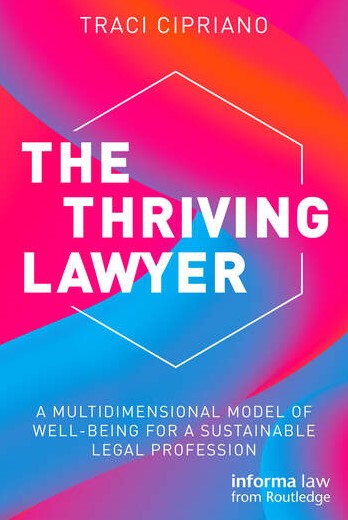
Well-being, mental health and resilience are important themes in professional services – not just in legal firms. People are our most important asset and we need them to feel well and able to take on challenges in order to provide exceptional client service and to be productive. This book will be food for thought for human resource professionals and professional service firm leaders who wish to retain, protect and develop their top talent. Book review: The Thriving Lawyer by Traci Cipriano (resilience).
About the book – The Thriving Lawyer
The book is contemporary – being published in 2024.The author (Traci Cipriano) is American – both a former practising lawyer, a PhD clinical psychologist and former leader at the American Psychological Association (ASA)). The majority of the research and evidence in therefore based in United States but I suspect that most of the findings apply equally in the UK and the rest of the world.
The subtitle of this book is “A multidimensional model of well-being for a sustainable legal profession” which is also referred to as the honeycomb model of well-being:
- Self-care strategies and routine
- Work-life balance
- Personal relationships and social supports
- Attention to and overall physical and mental health
- Work environment, workload and unique work pressures
- Financial and other resources
Much of the book is devoted to examining the evidence of the problems. As each chapter is designed to stand alone, there’s a fair amount of repetition. There are also some anonymous quotes from lawyers she interviewed although I was surprised she didn’t talk to more human resources and mental health professionals. Sadly, there is not as much practical advice on how to use the excellent multidimensional “honeycomb model” to create and implement the safe and nurturing culture and environment.
Nevertheless, the author highlights the complex interplay of the issues in the profession, organizations and individuals well. There’s enough evidence to convince hard-nosed, commercial senior partners who still dismiss organizational change management and well-being programmes as a “touchy feely” waste of money.
However, the overwhelming feeling I took from the book was that the onus was on the individual lawyers and members of staff – rather than the law firms. The templates in the appendices also reflect individual action. So, on the topic of organisational and culture change to promote well-being I would recommend the following two books as well:
- Book review: The Management Shift by Vlatka Hlupic (kimtasso.com) October 2022. Particularly in how it links the personal and organisational aspects
- Book review: Neuroscience for organizational change by Hilary Scarlett (kimtasso.com) May 2020
There’s a paragraph near the end of the book which mirrors my reaction: “Generation Z in particular does not want to experience what the Japanese call ‘karoushi’, or death by over work and they are voting with their feet. Gallup survey results in 2021 found that the number one thing Gen Z want from their employer is concern for their well-being. Similarly, a 2021 Bloomberg Law survey found the top three reasons why lawyers were leaving their jobs were 1. Better work-life balance 2. Reduce work stress and 3. Increase focus on personal life”
The problem of poor mental health in the legal profession is described in great detail
The World Health Organisation (WHO) defines mental health as “a state of wellbeing in which an individual realises his or her own abilities, can cope with the normal stresses of life, can work productively and is able to make a contribution to his or her community”. Other experts reflect on the presence of positive feeling and positive function in life.
The author brings a critical eye and proper analysis of the unhealthy aspects of law firm culture formed in part by achievement-oriented professionals who believe hard work is the best route to success.
“These surveys confirm what we have long suspected: The legal profession is universally a high-pressure profession dominated by competitive perfectionism, with little room for error, low psychological safety and high rates of burnout, depression, anxiety and substance misuse”.
There’s an analysis of the occupational risks – time pressures, multiple competing deadlines, billing pressures, rainmaking pressures, the adversarial nature of the profession, “pay your dues” attitudes and the rapid advance of technology which further blurs the work-life lines. Some types of law may expose lawyers to vicarious trauma.
There’s a repeated message about the dangerous ways of thinking that are taught in law school – notably to dispense with emotions which allegedly cloud judgment. As a result, lawyers are often not tuned into internal signs of distress such as bodily signals, negative thinking or negative emotions. Possibly a nod towards the tendency for lawyers to be high on IQ (intelligence) but lower on EQ (emotional intelligence).
The book explores the mind-body connection (the links between long term stress, mood and physical impacts on blood pressure, the immune function, heart attack, stokes, cancer, addictions, insomnia etc).
Hans Selye described stress in 1936 as “a non-specific physiological response (activation of the fight-flight-freeze-fawn response) to any demand for change, attention or action including an actual or perceived threat”. The author also shares his views on general adaptation syndrome (alarm reaction, resistance phase, exhaustion). For those of you who are interested, two great books on the mind-body connection are “The body keeps the score” by Bessel van der Kolk MD and “When the body says No” by Gabor Mate). Perma-stress (chronic stress) also impairs cognitive performance (problem-solving, memory and concentration) which should also be a concern as this too might have risk implications for firm’s professional indemnity insurance.
She presents evidence to show that stress and depression can shrink your brain impacting brain areas related to self-control and emotions – thus the increased likelihood of anger and hostility. And outlines the direct healthcare costs as well as decreased productivity.
The remedies, solutions and actions
What I like most about the book is the simple honeycomb model of well-being which is shared right at the outset. The author adds that the model must be intentional, multidimensional, individual and organisation, evidence based, individualised and always evolving.
While the author is right in explaining that there is no “one size fits all” approach to creating a healthy environment and culture in which lawyers might thrive, it would be helpful to have some tools so firms could assess where they should prioritise strategies and action.
This is partly explained when she explores how personality types means that each individual’s response to stressful situations and adversity may be different. And the value of optimum stress levels (Yerks-Dodson Law). Again, back to that interplay between organisational environment and individual propensity to stress.
There’s also recognition of the role of toxic cultures and leaders. I noted the 2022 thematic analysis by Sull involving 1.3 million Glassdoor.com employer reviews of 40 large US corporations identifying:
- Disrespectful
- Non-inclusive
- Unethical
- Cut-throat
- Abusive
I also enjoyed the analysis of different types of “toxic” lawyer types including (I did my own analysis way back in 2007: How do I deal with difficult partners? – Kim Tasso):
- Exploding hostile lawyer, overt abuse and perpetuation of negative workplace culture
- Quietly manipulative lawyer and insidious toxicity of passive-aggressive behaviour
Some of the remedies, solutions, interventions and actions mentioned to improve mental health include:
- Cultural change – so that well-being becomes a way of being and is enshrined in the firm’s values and priorities (“Burnout has been conceptualised to reflect six areas of incongruity in the workplace: workload, control, reward, community, fairness and values”)
- Help individuals find a sense of meaning and purpose
- Flexible working arrangements to support healthy routines
- Address time management challenges (particularly the “good enough is good enough” approach)
- The need for good role models – senior people who walk the talk on best practice
- Ensuring that policies are observed in practice (e.g. contact out of hours, working during vacations, comprehensive insurance coverage etc)
- Education and encouragement for self-care routines
- Calling out toxic leaders – zero tolerance of bullying
- Active diversity, equality and inclusion practices and policies
- Coaching and mentoring
- Promote trust, psychological safety and an appreciative environment How to facilitate groups – 2 (Herding cats in professional services) (kimtasso.com)
- Encourage more optimistic outlooks (while avoiding toxic positivity)
- Reducing stigma of self-care and mental health
- Identifying stoicism and avoidance
- Meditation and relaxation apps
- Mindfulness, grounding and breathing training and exercises
- Promoting autonomy (time management and boundary setting)
- Surveys to assess toxic cultures
- Establishing regular and healthy feedback
- Scheduling future events to support anticipatory pleasure
- Emotional intelligence training
- Nutrition programming
- Physical exercise classes such as yoga
- Resilience building training programmes
- Journalling and gratitude exercises
- Minimise role conflicts (ie ensure enough time is available for family responsibilities)
- Substance abuse and addiction recovery programmes
- Promote financial wellbeing with education programmes and access to expert advice
- Ensure staff take time and make a priority for personal relationships and support networks
- Providing self-care hacks – ensure people take time to rest, recharge and reconnect
- Checklist of questions for practitioners to ask themselves to identify where change is required
- Provide Employee Assistance Programmes (EAP) for access to confidential counselling and psychotherapy services
In the UK, we also have the Mental Health First Aid https://mhfaengland.org/ movement. This is a fantastic certification that improves knowledge of mental health issues throughout an organisation and goes a long way to helping firms identify those at risk of mental health issues.
Book contents
- Introduction to lawyer well-being and a guide to reading the book
- Introducing the multidimensional model of lawyer wellbeing (the honeycomb model of well-being – a way of being)
- Attention to overall physical and mental health – the Mind-body connection and impact of stress on health and performance
- Self-care strategies and overcoming barriers to healthy routines
- Understanding and addressing workplace issues which impact well being
- Managing work-life balance for well-being
- The impact of financial resources on well-being
- The essential role of personal relationship and social supports in well-being
- Cultivating meaning and purpose for well being
Lawyer suicide
(Trigger warning – This material contains information about suicide)
In the book, the author shares statistics from the US Centers of Disease Control and Prevention (CDC) from 2010s which found that lawyers ranked fourth in suicide rates when compared to other professions – behind dentists, pharmacists and physicians. The American Bar Association reported in 2022 that approximately 20% of lawyers and staff have considered suicide at some point.
I personally knew two lawyers – separated by decades – who took their own lives. I still often think of them both. One was a senior corporate partner in the North of England and the other a conveyancing paralegal in London. Like other who worked with them, I was deeply affected by their deaths and felt guilty that I hadn’t seen the warning signs. Yet, lawyer suicide continues as just a few of news reports reveal:
- Vanessa Ford, 47, a partner at Pinsent Masons law firm leapt in front of a train after she “consumed a significant amount of alcohol while undergoing an acute mental health crisis”. She died in September 2023
- Solicitor Roman Voronin, 52, jumped to his death following the onset of Parkinson’s disease in June 2023
- Marcus Malin, a family solicitor aged 48 in Hampshire, took his own life in December 2022
- In 2019, Paul Rawlinson, the former head of Baker McKenzie, took his own life after suffering from an “acute depressive illness”
- Victoria Metcalf-Smith, a commercial property lawyer, took her own life in April 2021, having suffered a dramatic change of mood while entering the menopause. She was 51.
- Kristof Fabry was an associate solicitor in the property department of central London law firm Statham Gill Davies died on 14 May 2019 – five days after being fired.
- Geraint Thomas, 47, from Cardiff who worked for Eversheds Sutherland, jumped from cliffs in December 2018
- Stephen Gale, a partner at Herbert Smith Freehills, was found dead in the bath of his London flat, having taken a fatal drugs overdose in 2014
- David Latham, a partner at Hogan Lovells struggling with work-related stress, died in 2013 a day after he told a colleague that he was going to kill himself
The City lawyers working themselves to death (telegraph.co.uk) March 2024
Solicitor, 48, who worked on cases for struggling clients for free killed himself after racking up huge debts | Daily Mail Online September 2023
Why Are Lawyers at Greater Risk of Suicide? | Psychology Today United Kingdom April 2023
One in 10 young lawyers worldwide ‘experiencing suicidal thoughts’ | News | Law Gazette April 2021
Sources of help for suicidal thoughts:
LawCare is the mental health charity for the legal sector.
Tips for coping with suicidal feelings right now – Mind
Suicide Prevention | SOS Silence of Suicide
Homepage | Campaign Against Living Miserably (CALM) (thecalmzone.net)
SPUK – Suicide Prevention UK Charity 1187866
Details of my counselling and therapy practice: Tasso Talking Therapy
Coaching Skills Academy
The Managing Partners’ Forum | (mpfglobal.com) and the Home – PM Forum have launched a collaborative initiative called Coaching Skills Academy – PM Forum. This offers a range of half day workshops for leaders on coaching and mentoring topics, as well as on resilience:
1st October – Coaching Teams – A Practical Toolkit (Jamie Butler) Coaching Teams – A Practical Toolkit – PM Forum
15th October – Meaningful Mentoring (Andy Lopata) Meaningful Mentoring – PM Forum
5th November – Introduction to coaching and mentoring skills (Kim Tasso) Introduction to coaching and mentoring skills – PM Forum
25th November – Developing People’s Resilience (Kim Tasso) Developing people’s resilience – PM Forum
19th December – Advanced Coaching Skills (Kim Tasso) Advanced Coaching Skills – PM Forum
Related Posts on stress, resilience and mental health
Building Resilience – Regulation, Reframing, Relationships (kimtasso.com) May 2020
we’re all in the same (stressed) boat (kimtasso.com) May 2024
The Tools – Five life-changing techniques to unlock your potential (kimtasso.com) April 2024
What do you do when your boss is a micro-managing control freak? (kimtasso.com) March 2024
Kim Tasso qualifies as a psychotherapeutic counsellor January 2024
Book review: How to do the work (recognise your patterns (kimtasso.com) December 2023
leadership conversation skills: SCARF model of neuroscience (kimtasso.com) October 2023
Dr Julie Smith (Mental Health Guidance) (kimtasso.com) July 2023
Boosting Your Confidence at Work – A Toolbox for Success (kimtasso.com) July 2023
Future Marketing/BD Manager – Build resilience (kimtasso.com) March 2023
Overcoming clinical depression (2021) by Oliver Kamm (kimtasso.com) March 2023
What do you do when a male colleague doesn’t like women? (gender bias) (kimtasso.com) February 2023
Soft skills revisited – with a leadership perspective (kimtasso.com) November 2022
Book review: The Management Shift by Vlatka Hlupic (kimtasso.com) October 2022
Disabled and down but definitely not out – A story of hope after a year (kimtasso.com) September 2022
Book review: The psychology of successful women by Shona Rowan (kimtasso.com) June 2022
Emotional Regulation – A key element of Emotional Intelligence (EQ) (kimtasso.com) August 2021
Book review: Digital Body Language – How to build trust by Erica Dhawan (kimtasso.com) June 2021
Dealing with “difficult” people – Nine strategies for dealing with arrogance (kimtasso.com) June 2021
Managing client complaints – Process, anger and apologies (kimtasso.com) June 2021
Improve your resilience – tools to help you cope in difficult times (kimtasso.com) November 2020
Book launch: Essential soft skills for lawyers – some research findings (kimtasso.com) July 2020
Your personal transition – Endings, neutral zone and new beginnings (kimtasso.com) June 2020
Change process – Emotions when reacting to change (kimtasso.com) April 2020
Lost connections – Why you’re depressed by Johann Hari (kimtasso.com) October 2019
Conference report: British Psychological Society’s (BPS) (kimtasso.com) July 2019
Change management and creativity – the adaptive third (kimtasso.com) June 2016
Future Marketing Managers need Finnish “sisu” for success (kimtasso.com) April 2015
10 tips to increase your resilience – Kim Tasso March 2013
Crazy busy – Book review – Dealing with stress (kimtasso.com) October 2009
What can I do to beat stress? – Kim Tasso July 2009







